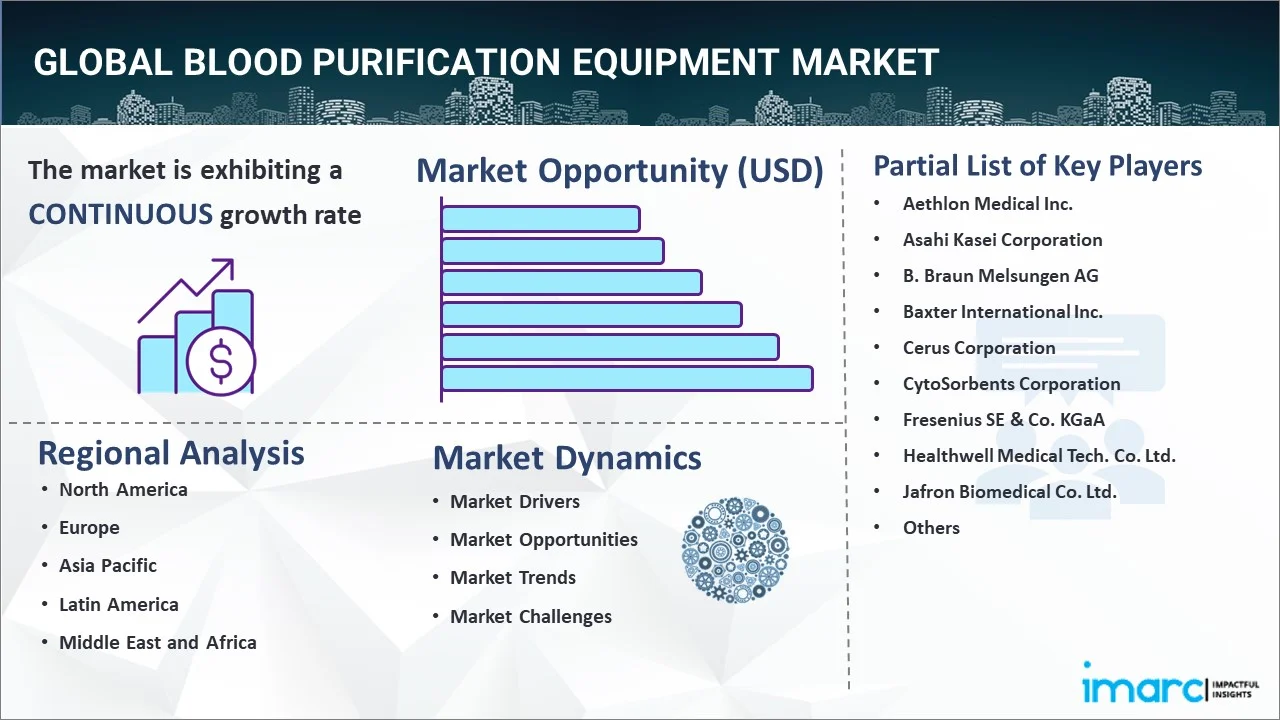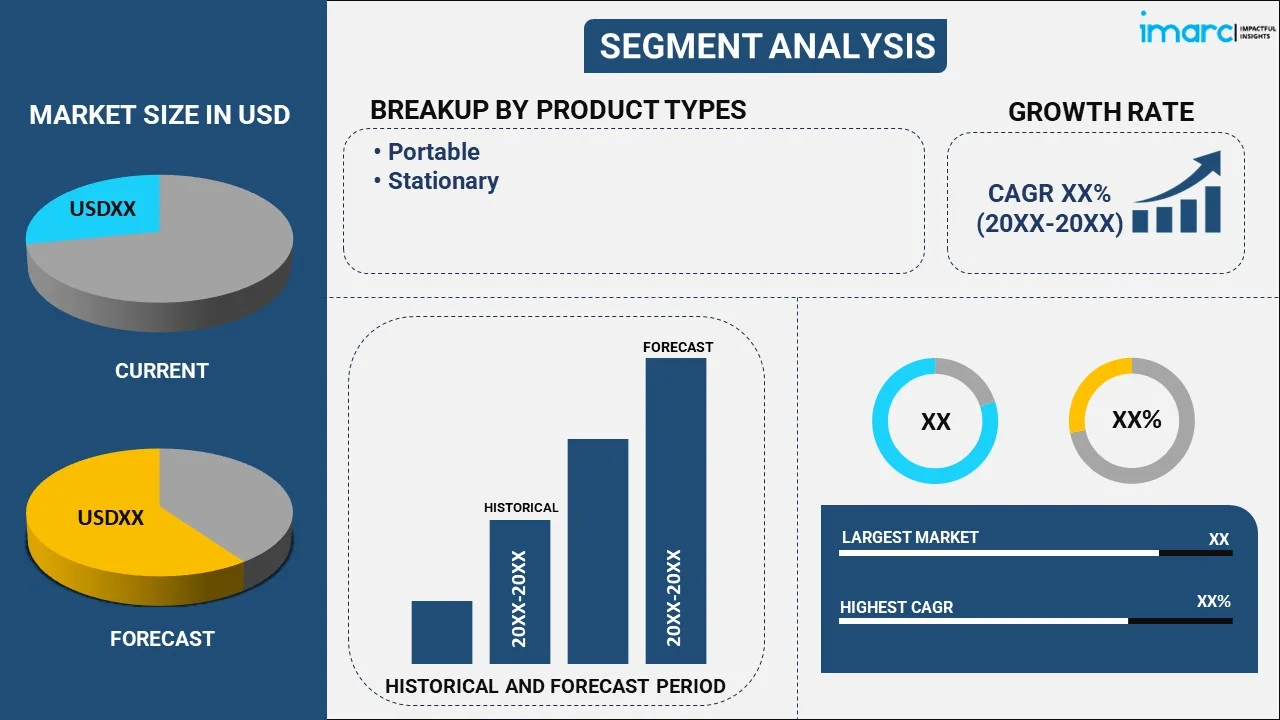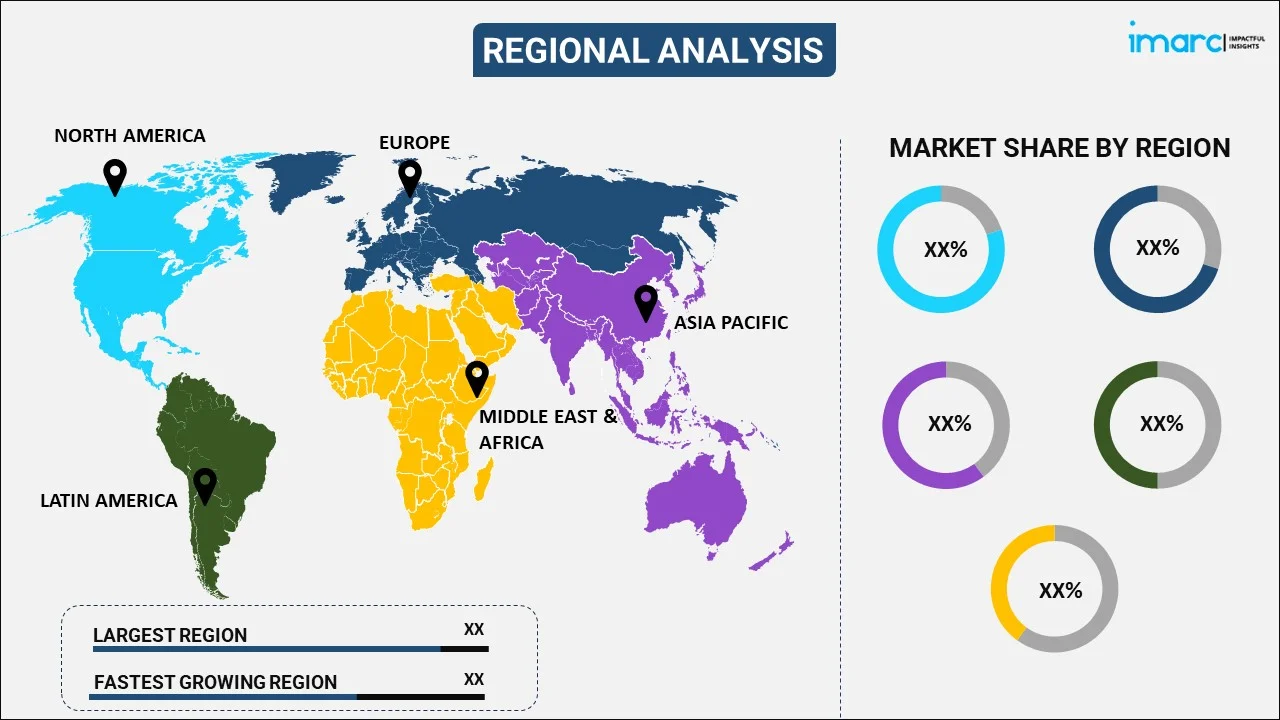
Blood Purification Equipment Market Report by Product Type (Portable, Stationary), Indication (Sepsis, Renal Diseases, and Others), End User (Hospitals and Clinics, Dialysis Centers, and Others), and Region 2025-2033
Blood Purification Equipment Market Size:
The global blood purification equipment market size reached USD 22.2 Billion in 2024. Looking forward, IMARC Group expects the market to reach USD 36.7 Billion by 2033, exhibiting a growth rate (CAGR) of 5.76% during 2025-2033. The increasing prevalence of kidney disorders, increasing number of patients requiring critical care, and various technological advancements are major factors propelling the market growth.
|
Report Attribute
|
Key Statistics
|
|---|---|
|
Base Year
|
2024
|
|
Forecast Years
|
2025-2033
|
|
Historical Years
|
2019-2024
|
|
Market Size in 2024
|
USD 22.2 Billion |
|
Market Forecast in 2033
|
USD 36.7 Billion |
| Market Growth Rate 2025-2033 | 5.76% |
Blood purification equipment refers to the medical devices used for extracting and purifying the patient’s blood. The equipment withdraws the blood to remove impurities and pumps the purified blood back into the body. Some of the commonly used equipment include hemodialysis, blood filtration, continuous renal replacement therapy (CRRT), hemoperfusion and plasma exchange devices. They are commonly utilized for the treatment of organ or renal failures and immune-metabolic disorders and for plasmapheresis procedures and are widely used across hospitals, clinics and ambulatory surgical centers.

Blood Purification Equipment Market Trends:
Increasing prevalence of kidney diseases
The demand for blood purification equipment is a consequence of the rapidly increasing incidence of chronic kidney diseases (CKD) and end-stage renal disease (ESRD). Since damaged kidneys fail to filter waste from the blood, patients are increasingly in need of dialysis or other purification techniques. The increasing number of people infected with CKD; global health statistics, rising demand for hemodialysis equipment, and hemofiltration equipment, coupled with the aging population, whereby older people are more prone to health problems associated with the kidneys, translates to higher market growth. Manufacturers continually develop equipment that is more efficient, safer, and comforting for patients receiving such treatments. The healthcare infrastructure both in the developed and developing countries is expanding the dialysis infrastructure, thereby bringing this type of blood purification technology to a wider population base, that creates a positive blood purification equipment market outlook.
Technological advancements in blood purification
An additional prime factor catalyzing the blood purification equipment market growth is the development of blood purification technologies at a higher level of advancement. Improvement in filtration and adsorption techniques has made toxins, immune complexes, and metabolic wastes removed from the blood with much greater efficiency. Better outcomes in patients suffering from sepsis, autoimmune diseases, and various organ failures may be achieved through modern devices, such as high-flux dialyzers and advanced hemoperfusion cartridges. Portable and wearable blood purification systems are now being introduced to the market, thus giving more mobility to the patients who may need to have multiple treatments. Therefore, these technologies will continue to unfold beyond dialysis as blood purification will now be developed for acute and chronic disease applications, providing healthcare providers and equipment manufacturers with a chance to treat a larger number of health conditions.
Increasing demand for critical care treatment
The increasing number of patients requiring critical care, particularly in intensive care units (ICUs), is propelling the growth of the blood purification equipment market. Critical conditions like sepsis, multi-organ failure, and severe inflammatory responses often require the use of blood purification techniques to remove harmful substances and stabilize the patient’s condition. During the COVID-19 pandemic, blood purification equipment became essential in treating critically ill patients with severe complications. The growing awareness about the benefits of extracorporeal blood purification therapies in managing life-threatening conditions is driving demand in hospitals and emergency settings. Additionally, government healthcare spending on enhancing ICU infrastructure and equipping them with advanced purification devices is significantly contributing to market growth.
Blood Purification Equipment Market Segmentation:
IMARC Group provides an analysis of the key trends in each segment of the market, along with forecasts at the global, regional, and country levels for 2025-2033. Our report has categorized the market based on product type, indication and end user.
Breakup by Product Type:

- Portable
- Stationary
Breakup by Indication:
- Sepsis
- Renal Diseases
- Others
Breakup by End User:
- Hospitals and Clinics
- Dialysis Centers
- Others
Breakup by Region:

- North America
- United States
- Canada
- Asia-Pacific
- China
- Japan
- India
- South Korea
- Australia
- Indonesia
- Others
- Europe
- Germany
- France
- United Kingdom
- Italy
- Spain
- Russia
- Others
- Latin America
- Brazil
- Mexico
- Others
- Middle East and Africa
Competitive Landscape:
The report has also provided a comprehensive analysis of the competitive landscape in the global blood purification equipment market. Detailed profiles of all major companies have also been provided. Some of the companies covered include:
- Aethlon Medical Inc.
- Asahi Kasei Corporation
- B. Braun Melsungen AG
- Baxter International Inc.
- Cerus Corporation
- CytoSorbents Corporation
- Fresenius SE & Co. KGaA
- Healthwell Medical Tech. Co. Ltd.
- Jafron Biomedical Co. Ltd.
- Kaneka Corporation
- Medtronic plc
- Nikkiso Co ltd.
- Spectral Medical Inc.
Kindly note that this only represents a partial list of companies, and the complete list has been provided in the report.
Blood Purification Equipment Market News:
- In August 2023, Terumo Blood and Cell Technologies (Terumo BCT) announced that the Reveos automated whole blood processing system has been cleared by the United States Food and Drug Administration (FDA), making it the first whole blood automation device available in the United States. The system processes whole blood into platelets and other components in a single centrifugation cycle. The automated processing of whole blood on the Reveos system, the only device of its kind in the world, will improve blood and platelet supplies for patients in the United States.
- In June 2024, CytoSorbents Corporation (NASDAQ: CTSO), a leader in the treatment of life-threatening conditions in the intensive care unit and cardiac surgery using its proprietary polymer adsorption technology, announced the launch of its PuriFi™ hemoperfusion machine in the E.U., following approval and certification under the E.U. Medical Device Regulation.
Blood Purification Equipment Market Report Scope:
| Report Features | Details |
|---|---|
| Base Year of the Analysis | 2024 |
| Historical Period | 2019-2024 |
| Forecast Period | 2025-2033 |
| Units | Billion USD |
| Segment Coverage | Product Type, Indication, End User, Region |
| Region Covered | Asia Pacific, Europe, North America, Latin America, Middle East and Africa |
| Countries Covered | United States, Canada, Germany, France, United Kingdom, Italy, Spain, Russia, China, Japan, India, South Korea, Australia, Indonesia, Brazil, Mexico |
| Companies Covered | Aethlon Medical Inc., Asahi Kasei Corporation, B. Braun Melsungen AG, Baxter International Inc., Cerus Corporation, CytoSorbents Corporation, Fresenius SE & Co. KGaA, Healthwell Medical Tech. Co. Ltd., Jafron Biomedical Co. Ltd., Kaneka Corporation, Medtronic plc, Nikkiso Co ltd., Spectral Medical Inc., etc. |
| Customization Scope | 10% Free Customization |
| Post-Sale Analyst Support | 10-12 Weeks |
| Delivery Format | PDF and Excel through Email (We can also provide the editable version of the report in PPT/Word format on special request) |
Key Questions Answered in This Report
The global blood purification equipment market was valued at USD 22.2 Billion in 2024.
We expect the global blood purification equipment market to exhibit a CAGR of 5.76% during 2025-2033.
The sudden outbreak of the COVID-19 pandemic has led to the increasing demand for blood purification equipment to filter the pathogens, cytokines, and other inflammatory mediators from the blood to improve the immunity against the coronavirus infection.
The rising prevalence of metabolic, immune, and kidney-related disorders, along with the growing adoption of blood purification equipment for treating organ or renal failures and plasmapheresis procedures, is primarily driving the global blood purification equipment market.
Based on the product type, the global blood purification equipment market can be categorized into portable and stationary. Currently, portable accounts for the majority of the global market share.
Based on the indication, the global blood purification equipment market has been segregated into sepsis, renal diseases, and others. Among these, renal diseases currently hold the largest market share.
Based on the end user, the global blood purification equipment market can be bifurcated into hospitals and clinics, dialysis centers, and others. Currently, dialysis centers exhibit a clear dominance in the market.
On a regional level, the market has been classified into North America, Asia-Pacific, Europe, Latin America, and Middle East and Africa, where Asia-Pacific currently dominates the global market.
Some of the major players in the global blood purification equipment market include Aethlon Medical Inc., Asahi Kasei Corporation, B. Braun Melsungen AG, Baxter International Inc., Cerus Corporation, CytoSorbents Corporation, Fresenius SE & Co. KGaA, Healthwell Medical Tech. Co. Ltd., Jafron Biomedical Co. Ltd., Kaneka Corporation, Medtronic plc, Nikkiso Co ltd., and Spectral Medical Inc.
Need more help?
- Speak to our experienced analysts for insights on the current market scenarios.
- Include additional segments and countries to customize the report as per your requirement.
- Gain an unparalleled competitive advantage in your domain by understanding how to utilize the report and positively impacting your operations and revenue.
- For further assistance, please connect with our analysts.
 Inquire Before Buying
Inquire Before Buying
 Speak to an Analyst
Speak to an Analyst
 Request Brochure
Request Brochure
 Request Customization
Request Customization




.webp)




.webp)












